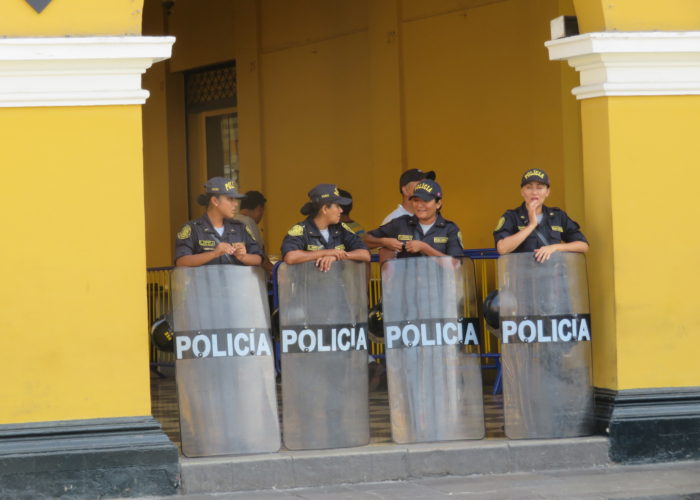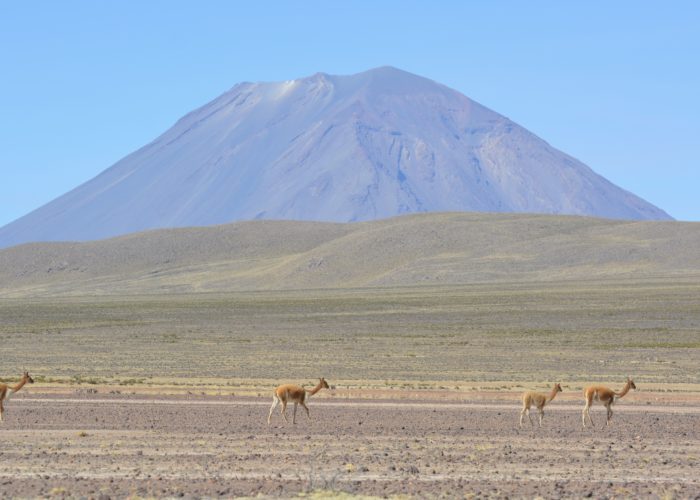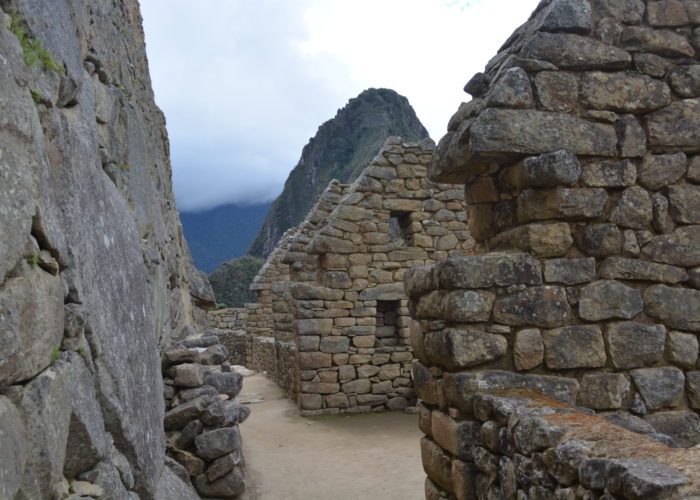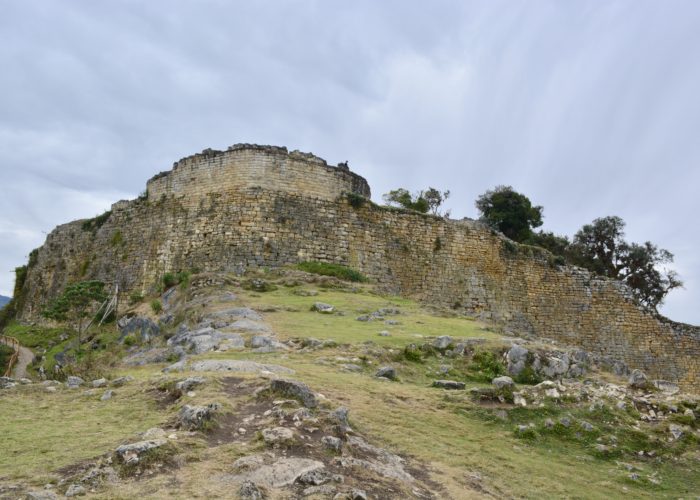Peru is your archetypal South American country with an intoxicating mixture of Andean culture, colourful markets, spectacular scenery, elegant colonial cities and probably South America’s best cuisine.
Most visitors make pretty much the same tour around Peru that takes in an arc from Cuzco down to Lake Titicaca across to Arequipa and then up to Lima through Nazca and Paracas. However there is much more to Peru than these A list sites. Even small detours of this circuit offer unspoiled sites far away from the hoards of mass tourism.
The North of Peru offers multiple archaeological sites, the highest peaks on the equator and small Peruvian towns, all well away from the gringo trail. Peru’s economy is developing rapidly and there is a large growth in the middle classes, who are beginning to extensively travel round their country. For example in the pre Incan site of Kuelap, there are many Peruvian tourists discovering their heritage.
Peru’s cuisine is gaining great popularity across the world, and in the cities like Lima and Arequipa there are multiple fine dining experiences on offer, where the chefs create innovative and tasty dishes that showcase the many fine ingredients available in Peru. Ceviche is the classic Peruvian dish, but it is also worth trying alpaca, a very healthy lean meat, and also the many variations of potatoes, corn and other vegetables.
Peru’s economy has been developing well off the back of the boom in commodity prices and as a result there are some very wealthy enclaves in Lima and other cities. However there is still a large dichotomy of wealth and this can spontaneously spill out into demonstrations. In Lima and the large cities it is not uncommon to see riot police in the side streets.
Destinations

- Lima
- Paracas
- Huacachina
- Nazca
- Arequipa
- Colca Canyon
- Puno
- Cusco
- Machu Picchu
- Kuelap
- Huaraz, Chavin
- Trujillo & Chan Chan
- Northern Beaches
1.Lima

Lima has grown into a massive city with a population of 9.7 million people and dominates life in Peru. It acts as the principal gateway into the country and any visit to Peru will probably involve multiple visits to Lima. On our journey we transited through Lima’s airport seven times.
Lima was the cradle of the Spanish Empire in Peru, and its city centre contains many fine churches and government buildings. Indeed the old colonial Lima Centro is a UNESCO World Heritage Site and in particular the two principal squares have elegant symmetrical buildings on all sides. The Presidents Palacio de Gobierno sits at one end of Plaza Mayor, with the main cathedral and government buildings on the other sides demonstrating the combined power of government and church that dominates Peru.
The suburb of Miraflores, contains fine shopping and is probably the place of choice to stay, given the large number of bars and restaurants there. Lima also has a significant number of fine dining restaurants that show case Peru’s cuisine’s burgeoning reputation.
2. Paracas

The Paracas National Reserve is a unique reserve where the dry desert meets the sea in a land that receives minimal rainfall. The Paracas Trident is a 128 metre high carving of a candelabra that overlooks the sea and dates from a similar time to the Nazca lines and has been preserved by the dry climate over many hundreds of years.
Offshore are the Ballesta Islands which contain an abundance of sea birds and marine life. Indeed they have been called a mini version of the Galapagos Islands, and while that is stretching it a lot, nevertheless taking a boat trip out to the islands to witness all the sea birds, including some of the most northerly penguins is well worth the experience.
3.Huacachina

Further south is the unusual oasis of Huacachina, a lagoon surrounded by a large expanse of sand dunes that has become a major backpacker resort in recent years. Buggy trips over the dunes can be a big adrenaline rush, though care needs to be taken with some of the machismo drivers. Sand boarding down the dunes is much harder than it looks but is another not to be missed experience.
4.Nazca

The Nazca Lines are the subject of many mysteries, including extra terrestrial visitors. To be appreciated you need to take a light aircraft from the small airport at Nazca, which takes you on a short half hour flight over many of the animal shapes, lines and hieroglyphs. The Pan American Highway also takes you close to two of the shapes, where you can see that they are made up of small indentations in the dry rock and appreciate how fragile and delicate they are.
While in Nazca it is also worth visiting the Temple Escalonado outside the city of Nazca, which is only now being excavated, and helps give a fuller appreciation of the culture that built the lines.
5. Arequipa

Peru’s second city, Arequipa with its compact colonial buildings, cobbled streets and its backdrop of the surrounding mountains and volcanos is one of the most attractive cities in all of Latin America. Sitting at 2,335 metres above sea level, it has a pleasant climate all year round, and with the surrounding mines and agriculture, it is also one of the wealthiest cities in Peru.
Its many colonial churches some with ornate facades and carvings reflect the varied history of the Spanish colonialists and the multiple Catholic saints under who’s inspiration they used to justify their exploits. The main cathedral sits on one side of the Plaza de Armas with its twin towers, one recently rebuilt following the earthquake in 2001, while the rest of the square has attractive symmetrical colonnaded buildings, which makes this an attractive central point to the city.
Arequipa is well and truly on Peru’s tourist circuit both in its own right and also the focal point for trips to the nearby Colca Canyon. Many of the central buildings have been taken over by the tourist trade, from souvenir shops, travel agents, bars hotels and restaurants. Most of the local population lives outside the centre, but the city still retains its Peruvian charm, especially when the many festivals and parades take over the elegant Plaza de Armas.
6. Colca Canyon

One of the deepest canyon’s in the world that contains some of the most impressive scenery in Peru. The canyon in places is up to a kilometre deep down to the Río Colca below. There are many examples of Inca terracing all around the canyon together with the symbolic piles of Inca stones. The Mirador Cruz del Condor is a fine place to view families of condors soaring on the thermals that rise in the canyon.
The main road from Arequipa takes you across the Andean Altiplano with its many different shares of colours, wide open spaces, framed by mountains and the iconic Andean floor and fauna. Herds of wild guanacos and the more domesticated llamas and alpacas make an interesting contrast to the dramatic scenery. Spectacular volcanoes pepper the horizon in all directions and some of the passes the road climbs rise to 4,900 meters making this one of the highest places to visit that doesn’t involve climbing mountains.
7. Puno

Lake Titicaca as every geography student learns at school is one the highest navigable lakes in the world. The Lake is one of the most important sites in Incan and pre-Incan culture and as legend has it is shaped like a puma. The gateway to the Lake is the Peruvian town of Puno, which while laking some of the spectacular buildings of Arequipa and Puno, still has more than enough to keep a visitor occupied for a number of days. Also it has a much more distinctly Peruvian feel as its centre despite still being full of travel agents and other paraphernalia of the tourist trade.
There are a number of important sites on the Lake to visit, and while pretty much geared to tourism, both the Uros Islands and Taquile Island make for picturesque day trips out of Puno. Locals on the reed beds of the Uros Islands dress up in their colourful costumes and welcome visitors to see what traditional life used to be like on the lake. Many of the individuals on the islands will live in Puno, with particularly the men in paid employment and their families dress up supporting the tourist trade on the islands.
9. Cuzco

Cuzco, the ancient capital of the Incas contains many treasures from the Inca Empire and those subsequently built by the Spanish, many on top of existing Inca structures. The Plaza de Armas with two imposing churches and colonnaded buildings symmetrically surrounding the square, forms the centre of Cuzco and many of the important sites are an easy walk along cobbled streets from the square. The Catedral sits on the foundations of the Inca Viracocha palace and symbolises in one building how the Spanish imposed their religion and culture on the Incas. The Catedral is imposing with lots of gold and treasures. One of the most unusual paintings to look out for is a version of the Last Supper, but with Andean food including corn and a guinea pig on the table.
Exploring the cobbled streets of Cuzco make for many a pleasant day or two, coupled with stop overs in the many bars and restaurants. Cuzco is at the centre of the tourist trade for Machu Picchu and the Scared Valley, and at times the town can feel a bit overrun by tourists. Not to be missed are the nearby Inca ruins of Sacsayhuaman which occupy a large site on hill just outside Cuszo, offering fine views of the old city, which is shaped like a puma. Some of the stones in Sacsayhuaman are enormous and the construction techniques with the angled interlocking stones are evidence of a very sophisticated and advance culture.
10. Machu Pichu & The Inca Trail

Trekking the Camino Inka is one of the great bucket list walks and it does not disappoint. There are a number of different routes, each lasting around three days that take you to Machu Picchu. To do any of them requires a fair bit of planning as permits and passes will have to be purchased before hand, often many months ahead in the case of the Classic Inca Trail. In addition as the treks rise to over the 4,000 metre mark, it is important to acclimatise to the altitude beforehand.
We took the Classic Inca Trail, which the authorities limit to 500 trekkers a day, which includes the porters, who effectively operate on a one for one basis. The trail generally can take that number of trekkers, but the last morning’s trek down to the Sun Gate can feel crowded. The Classic Inca Trail is the only one that offers visitors to witness the sun rise from the Sun Gate, though it can be reached at any other time from the main site.
The main site in its own right is one of the greatest tourist attractions in the world and if you have a clear day the views are picture postcard perfect. The authorities now limit any visit to half a day and there is a fixed route around the site that takes you to the major locations, there is no opportunity to retrace your steps, apart from booking a further visit the next day. Splitting you time over two days also gives you the opportunity to experience the light and atmosphere at the beginning and end of the day.
11. Kuélap & Chacapoyas

The pre-Incan site of Kuélap sitting onto of a remote mountain in Northern Peru has been touted in some quarters as the new Machu Picchu. While that is probably stretching it, nevertheless the archaeological ruins are well worth the logistical and transport challenges to get there. The site’s remoteness means that only the most intrepid tourists get there, though the new cable car has made access significantly easier.
The surrounding countryside contains a number of other pre-Incan sites, including the mud brick funerary buildings built on the mountainside at Ravesh. Also north of Chachapoyas are the Cataratas de Gocta, which at 771metres are one of the highest waterfalls in the world. The treks in the surrounding countryside take in some spectacular mountain scenery, flora and fauna without the crowds elsewhere in Peru.
12. Huaraz, Chavín & Cordillera Blanca

To the north of Lima is the area of Ancash where the snow capped peaks of the Cordillera Blanca, not only contains Peru’s highest mountain Huascarán which sits at 6,768 metres tall and is the tallest mountain on the equator in the world. Climate change and global warming is playing havoc with the amount of snow in the Cordillera, but the trek up to Laguna 69 the corrie lake at the top of Huascarán offers some great mountain views including the glaciers of Huascarán. The trek takes you up to 4,600 metres so requires a fair amount of acclimatisation to carry out.
Elsewhere in Ancash is the important archaeological site of Chavín de Huantar, that contains an important temple of the pre-Incan Chavín cult and a museum that is worth visiting. The Chavín temples contain many carvings of heads and gargoyles both externally on the temple walls and within its subterranean chambers.
14. Trujillio & Chan Chan
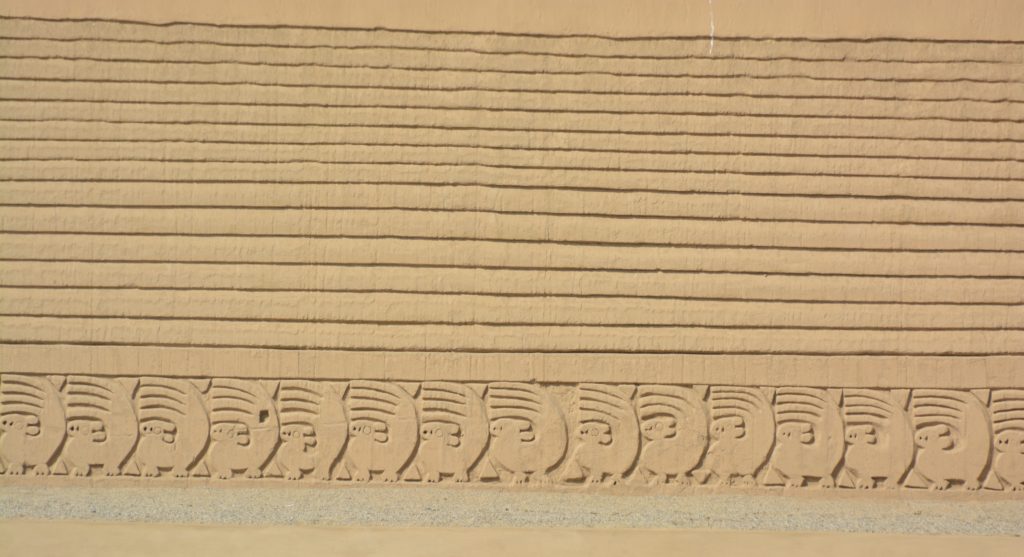
Further to the north along the Pacific coast is the university town of Trujillo which forms a convenient base to explore the nearby world renowned archaeological sites of Chan Chan and the large Moche sacred pyramids.
Chan Chan consists of a number of different adobe constructed sites created by the Chimu culture. The desert and dry climate meant that Chan Chan was covered by the sands, and today it is gradually being excavated. The detailed reliefs and carvings in the ochre sand coloured walls still look very sharp after over 600+ years.
The other main archaeological site near Trujillo are the Huacas del Moche, two temples built by the Moche around 600AD. The Huaca del Sol is the largest adobe structure in the Americas and is presently not accessible, but its sister complex, the Huaca de la Luna contains some brilliantly coloured frescos, which were remarkably preserved when the desert sands overran the complex and are now being excavated.
15. Northern Beaches

Towards the border with Ecuador, there are a number beach resorts which offer some fine Pacific surfing and time to relax after travelling some of the long distances through Northern Peru. One of the resorts is Punta Sal that has some fine sands and safe swimming, which in low season you can have pretty much to yourself.
Blogs
- Lima – Capital of Empire
- Huaraz – Gateway to the Cordillera Blanca
- Huanchaco – Pre Inca Civilizations of the North
- Lima – City Tour
- Arequipa and Colca Canyon
- Camino Inka and Machu Picchu
- Cusco – Colonial and Inca City
- Lake Titicaca – Holy Lake
- Southern Peru – Nazca, Huacachina and Paracas
- Kuélap, Chachapoyas and Northern Peru
Slideshow
Travel
Peru has a good intercity bus network and also internal flights are good value and make a sensible option if you need to cover big distances. Some of the mountain roads can be narrow with lots of bends and narrow passing places. The main intercity highways are well developed, though the rubbish piled up on the road side of the Pan American Highway is disappointing, indeed Peru and neighbouring Bolivia have a particular problem with rubbish on the roads.
We used a company called Peru Hop which offers great flexibility on the classic route round Peru between Cuzco, Lima and onwards to La Paz in Bolivia. Peru Hop run a bus between the major tourist destinations, running the same end to end route each day making it easy to hop on and off a particular route, with total flexibility as to how long you want to stay in each destination. We used Peru Hop for the classic arc between Cuzco, Take Titicaca and La Paz, and back through Arequipa and finishing in Lima.
For the northern part of Peru we took the Dragoman Lima to Quito route, which took in most of the archaeological sites up the Pan American Highway. In addition Dragoman offer access to the trekking opportunities in the National Parks. Travelling on an overland company like Dragoman gets you access to lots of places, including flexibility of truck stops on the way for photographs etc. but the timetable is fixed, not allowing you flexibility to extend your stay on route, which companies like Peru Hop offer. However with Peru Hop your journey is much more fixed between city locations, and offers less flexibility for on journey truck stops.
Trekking the Inca Trail requires pre-planning as there are only 500 permits a day, which includes porters, on the Classic Inca Trail. Often you will need to book the trail months in advance, though many companies like Dragoman will have pre-booked permits on their trips, which allow some flexibility, but again these are unlikely to offer last minute opportunities. There are other trails to Machu Picchu that offer different experiences and flexibility.
Elsewhere in Peru we used a mixture of land and air transport, including shared collectivos in the north where the transport leaves when it is full and you can be sharing with all sorts of produce and live animals. We did the Colca Canyon can be done with our own transport, which enabled us to have multiple stop points on route, there are many fantastic view points to be taken in, though the altitude in places is very high.
Costs
Peru as a whole is fairly reasonably priced by Latin American standards, and its currency, like most while we were travelling was slowly depreciating against the USD, making its costs manageable for visitors, but local inflation works in the opposite direction.
The banking system in the principal destinations is pretty efficient, with ATMs widely distributed and credit and debit cards accepted in most places. The banks will charge additional fees for cash withdrawals and these fees vary both between banks and also by geography. We found that Scotiabank Peru and Banco de Credito del Peru did not tend to charge locally for cash withdrawals.
Accommodation
There is a full range of accommodation options all over Peru, from the standard international hotels common place in all major cities to a whole variety of smaller hostels and boutique hotels. For the most part we used web based sites like booking.com to source our accommodation. The advantage of booking.com is that often you do not have to pay the full cost of accommodation in advance.
Peru Hop have a list of accommodation in each of the destinations they serve, and in some cases offer a discount to Peru Hop customers. They will also arrange for transport to collect its customers from a range of local hotels to the bus departure point. This saves waiting around in bus stations, which can often be in the outskirts of the towns.
Places we Stayed
- Lima: Hotel Kamana
- Lima: Holiday Inn Lima Airport
- Lima: Casa Andina Miraflores
- Arequipa: Casona Plaza Arequipa
- Cusco: Casa San Blas Boutique Hotel
- Aguas Calientes: Casa Andina Standard Machu Picchu
- Puno: Tierra Viva Puno Plaza
- Nazca: Nazca Travel One Hostel
- Huachina: La Casa Bamboo
- Paracas: Bamboo Lodge Paracas
- Kuelap: Ekokuelap Hospedaje Ecológico
- Huaraz: Joe’s Place
- Huanchaco: Hostel Naylap
- Punta Sal: Waitako Beach




